4.2: Vectors in the Plane
( \newcommand{\kernel}{\mathrm{null}\,}\)
Learning Objectives
- Describe a plane vector, using correct notation.
- Perform basic vector operations (scalar multiplication, addition, subtraction).
- Express a vector in component form.
- Explain the formula for the magnitude of a vector.
- Express a vector in terms of unit vectors.
- Give two examples of vector quantities.
When describing the movement of an airplane in flight, it is important to communicate two pieces of information: the direction in which the plane is traveling and the plane’s speed. When measuring a force, such as the thrust of the plane’s engines, it is important to describe not only the strength of that force, but also the direction in which it is applied. Some quantities, such as or force, are defined in terms of both size (also called magnitude) and direction. A quantity that has magnitude and direction is called a vector. In this text, we denote vectors by boldface letters, such as
Definition: Vector
A vector is a quantity that has both magnitude and direction.
Vector Representation
A vector in a plane is represented by a directed line segment (an arrow). The endpoints of the segment are called the initial point and the terminal point of the vector. An arrow from the initial point to the terminal point indicates the direction of the vector. The length of the line segment represents its magnitude. We use the notation
Vectors with the same magnitude and direction are called equivalent vectors. We treat equivalent vectors as equal, even if they have different initial points. Thus, if
Definition: equivalent vectors
Vectors are said to be equivalent vectors if they have the same magnitude and direction.
The arrows in Figure
The use of boldface, lowercase letters to name vectors is a common representation in print, but there are alternative notations. When writing the name of a vector by hand, for example, it is easier to sketch an arrow over the variable than to show it is a vector:
Example
Sketch a vector in the plane from initial point
Solution
See Figure
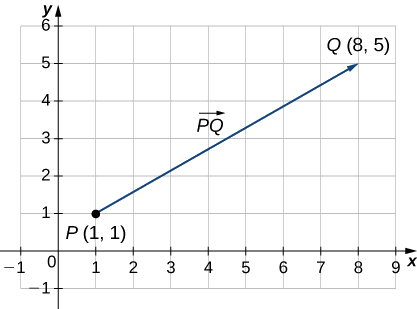
Exercise
Sketch the vector
- Hint
-
The first point listed in the name of the vector is the initial point of the vector.
- Answer
-
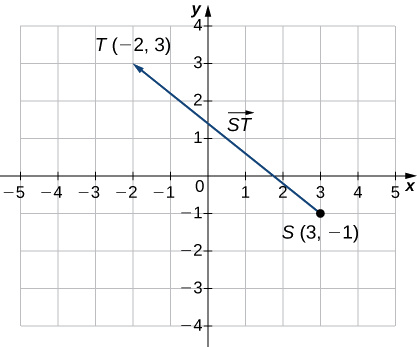
Combining Vectors
Vectors have many real-life applications, including situations involving force or velocity. For example, consider the forces acting on a boat crossing a river. The boat’s motor generates a force in one direction, and the current of the river generates a force in another direction. Both forces are vectors. We must take both the magnitude and direction of each force into account if we want to know where the boat will go.
A second example that involves vectors is a quarterback throwing a football. The quarterback does not throw the ball parallel to the ground; instead, he aims up into the air. The velocity of his throw can be represented by a vector. If we know how hard he throws the ball (magnitude—in this case, speed), and the angle (direction), we can tell how far the ball will travel down the field.
A real number is often called a scalar in mathematics and physics. Unlike vectors, scalars are generally considered to have a magnitude only, but no direction. Multiplying a vector by a scalar changes the vector’s magnitude. This is called scalar multiplication. Note that changing the magnitude of a vector does not indicate a change in its direction. For example, wind blowing from north to south might increase or decrease in speed while maintaining its direction from north to south.
Definition: Scalar Multiplication
The product
As you might expect, if
Note that
Another operation we can perform on vectors is to add them together in vector addition, but because each vector may have its own direction, the process is different from adding two numbers. The most common graphical method for adding two vectors is to place the initial point of the second vector at the terminal point of the first, as in Figure
A second method for adding vectors is called the parallelogram method. With this method, we place the two vectors so they have the same initial point, and then we draw a parallelogram with the vectors as two adjacent sides, as in Figure
Definition: Vector Addition
The sum of two vectors
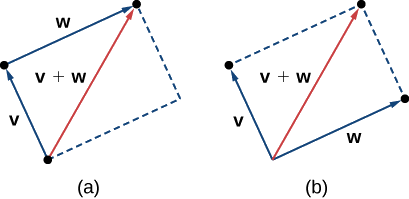
It is also appropriate here to discuss vector subtraction. We define
In Figure
This is known more generally as the triangle inequality. There is one case, however, when the resultant vector
Example
Given the vectors
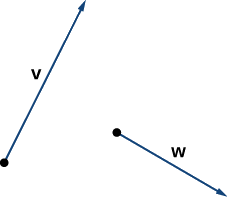
Solution
a. The vector
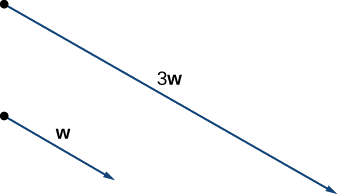
Vector
b. Use either addition method to find
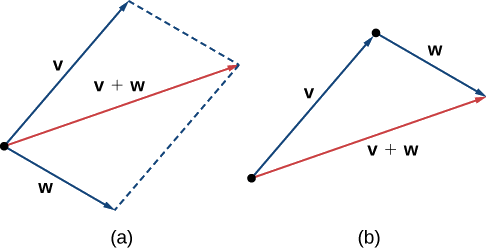
c. To find
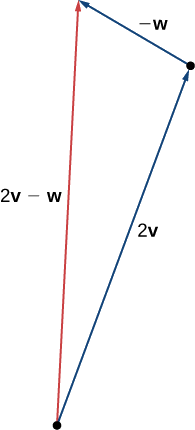
Exercise
Using vectors
- Hint
-
First sketch vectors
- Answer
-
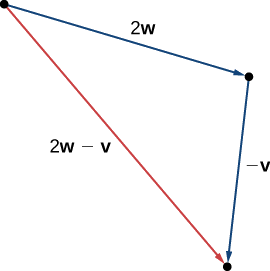
Vector Components
Working with vectors in a plane is easier when we are working in a coordinate system. When the initial points and terminal points of vectors are given in Cartesian coordinates, computations become straightforward.
Example
Are
a.
b.
Solution
a. The vectors are each
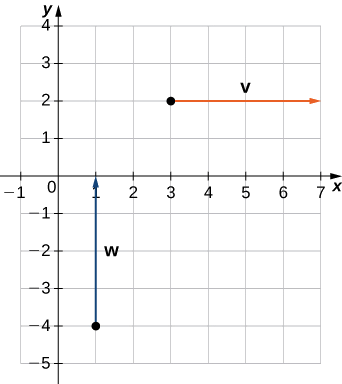
b. Based on Figure
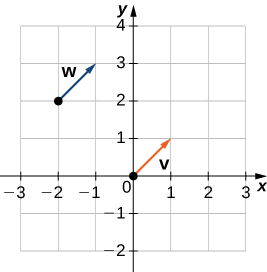
Exercise
Which of the following vectors are equivalent?
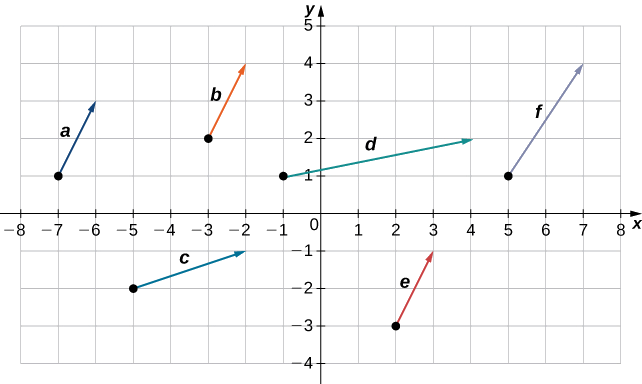
- Hint
-
Equivalent vectors have both the same magnitude and the same direction.
- Answer
-
Vectors
We have seen how to plot a vector when we are given an initial point and a terminal point. However, because a vector can be placed anywhere in a plane, it may be easier to perform calculations with a vector when its initial point coincides with the origin. We call a vector with its initial point at the origin a standard-position vector. Because the initial point of any vector in standard position is known to be
When a vector is written in component form like this, the scalars x and y are called the components of
Definition: Vector components
The vector with initial point
The scalars
Recall that vectors are named with lowercase letters in bold type or by drawing an arrow over their name. We have also learned that we can name a vector by its component form, with the coordinates of its terminal point in angle brackets. However, when writing the component form of a vector, it is important to distinguish between
When we have a vector not already in standard position, we can determine its component form in one of two ways. We can use a geometric approach, in which we sketch the vector in the coordinate plane, and then sketch an equivalent standard-position vector. Alternatively, we can find it algebraically, using the coordinates of the initial point and the terminal point. To find it algebraically, we subtract the
Rule: Component Form of a Vector
Let
Example
Express vector
Solution:
a. Geometric
1. Sketch the vector in the coordinate plane (Figure
2. The terminal point is 4 units to the right and 2 units down from the initial point.
3. Find the point that is 4 units to the right and 2 units down from the origin.
4. In standard position, this vector has initial point
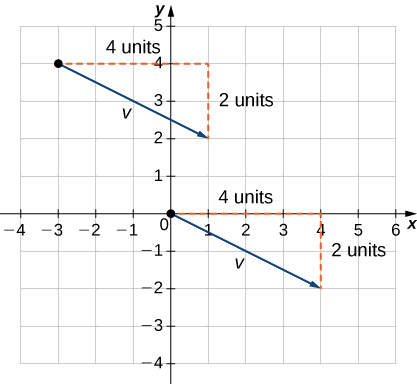
b. Algebraic
In the first solution, we used a sketch of the vector to see that the terminal point lies 4 units to the right. We can accomplish this algebraically by finding the difference of the
Similarly, the difference of the
So, in component form,
Exercise
Vector
- Hint
-
You may use either geometric or algebraic method.
- Answer
-
To find the magnitude of a vector, we calculate the distance between its initial point and its terminal point. The magnitude of vector
Note that because this vector is written in component form, it is equivalent to a vector in standard position, with its initial point at the origin and terminal point
Based on this formula, it is clear that for any vector
The magnitude of a vector can also be derived using the Pythagorean theorem, as in the following figure.
We have defined scalar multiplication and vector addition geometrically. Expressing vectors in component form allows us to perform these same operations algebraically.
Definition: Scalar multiplication and Vector addition
Let
- Scalar multiplication:
- Vector addition:
Example
Let
- Express
Solution
a. To place the initial point of
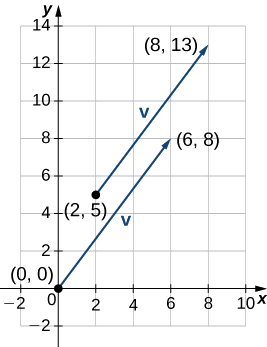
b. To find
c. To find
d. To find
Exercise
Let
- Find
- Express
- Find
- Hint
-
Use the Pythagorean Theorem to find
- Answer a
-
- Answer b
-
- Answer c
-
Now that we have established the basic rules of vector arithmetic, we can state the properties of vector operations. We will prove two of these properties. The others can be proved in a similar manner.
Properties of Vector Operations
Let
- Commutative property
- Associative property
- Additive identity property
- Additive inverse property
- Associativity of scalar multiplication
- Distributive property
- Distributive property
- Identity and zero properties
Proof of Commutative Property
Let
□
Proof of Distributive Property
Apply the distributive property (Equation
□
Exercise
Prove the additive inverse property.
- Hint
-
Use the component form of the vectors.
We have found the components of a vector given its initial and terminal points. In some cases, we may only have the magnitude and direction of a vector, not the points. For these vectors, we can identify the horizontal and vertical components using trigonometry (Figure
Consider the angle
Example
Find the component form of a vector with magnitude 4 that forms an angle of
Solution
Let
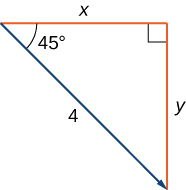
Exercise
Find the component form of vector
- Hint
-
- Answer
-
Unit Vectors
A unit vector is a vector with magnitude
Recall that when we defined scalar multiplication, we noted that
Example
Let
- Find a unit vector with the same direction as
- Find a vector
Solution:
a. First, find the magnitude of
b. The vector
Exercise
Let
- Hint
-
First, find a unit vector in the same direction as
- Answer
-
We have seen how convenient it can be to write a vector in component form. Sometimes, though, it is more convenient to write a vector as a sum of a horizontal vector and a vertical vector. To make this easier, let’s look at standard unit vectors. The standard unit vectors are the vectors
By applying the properties of vectors, it is possible to express any vector in terms of
Thus,
Example
- Express the vector
- Vector
Solution:
a. Resolve vector
b. Because
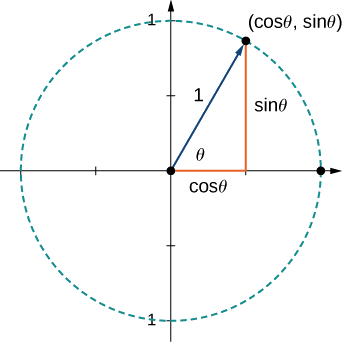
Exercise
Let
- Hint
-
Use sine and cosine to find the components of
- Answer
-
Applications of Vectors
Because vectors have both direction and magnitude, they are valuable tools for solving problems involving such applications as motion and force. Recall the boat example and the quarterback example we described earlier. Here we look at two other examples in detail.
Example
Jane’s car is stuck in the mud. Lisa and Jed come along in a truck to help pull her out. They attach one end of a tow strap to the front of the car and the other end to the truck’s trailer hitch, and the truck starts to pull. Meanwhile, Jane and Jed get behind the car and push. The truck generates a horizontal force of 300 lb on the car. Jane and Jed are pushing at a slight upward angle and generate a force of 150 lb on the car. These forces can be represented by vectors, as shown in Figure
Solution
To find the effect of combining the two forces, add their representative vectors. First, express each vector in component form or in terms of the standard unit vectors. For this purpose, it is easiest if we align one of the vectors with the positive
The second vector has magnitude
The angle
Example
An airplane flies due west at an airspeed of
Solution
Let’s start by sketching the situation described (Figure
Set up a sketch so that the initial points of the vectors lie at the origin. Then, the plane’s velocity vector is
When the airspeed and the wind act together on the plane, we can add their vectors to find the resultant force:
The magnitude of the resultant vector shows the effect of the wind on the ground speed of the airplane:
As a result of the wind, the plane is traveling at approximately
To determine the bearing of the airplane, we want to find the direction of the vector
The overall direction of the plane is
Exercise
An airplane flies due north at an airspeed of
- Hint
-
Sketch the vectors with the same initial point and find their sum.
- Answer
-
Approximately
Key Concepts
- Vectors are used to represent quantities that have both magnitude and direction.
- We can add vectors by using the parallelogram method or the triangle method to find the sum. We can multiply a vector by a scalar to change its length or give it the opposite direction.
- Subtraction of vectors is defined in terms of adding the negative of the vector.
- A vector is written in component form as
- The magnitude of a vector is a scalar:
- A unit vector
- Vectors are often used in physics and engineering to represent forces and velocities, among other quantities.
Glossary
- component
- a scalar that describes either the vertical or horizontal direction of a vector
- equivalent vectors
- vectors that have the same magnitude and the same direction
- initial point
- the starting point of a vector
- magnitude
- the length of a vector
- normalization
- using scalar multiplication to find a unit vector with a given direction
- parallelogram method
- a method for finding the sum of two vectors; position the vectors so they share the same initial point; the vectors then form two adjacent sides of a parallelogram; the sum of the vectors is the diagonal of that parallelogram
- scalar
- a real number
- scalar multiplication
- a vector operation that defines the product of a scalar and a vector
- standard-position vector
- a vector with initial point
- standard unit vectors
- unit vectors along the coordinate axes:
- terminal point
- the endpoint of a vector
- triangle inequality
- the length of any side of a triangle is less than the sum of the lengths of the other two sides
- triangle method
- a method for finding the sum of two vectors; position the vectors so the terminal point of one vector is the initial point of the other; these vectors then form two sides of a triangle; the sum of the vectors is the vector that forms the third side; the initial point of the sum is the initial point of the first vector; the terminal point of the sum is the terminal point of the second vector
- unit vector
- a vector with magnitude
- vector
- a mathematical object that has both magnitude and direction
- vector addition
- a vector operation that defines the sum of two vectors
- vector difference
- the vector difference
- vector sum
- the sum of two vectors,
- zero vector
- the vector with both initial point and terminal point
Contributors and Attributions
Gilbert Strang (MIT) and Edwin “Jed” Herman (Harvey Mudd) with many contributing authors. This content by OpenStax is licensed with a CC-BY-SA-NC 4.0 license. Download for free at http://cnx.org.





